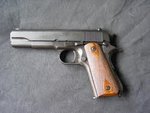- Thread starter
- #21
...
If needed 3rd and 4th men could be added as ammo carriers if belts were available and distances were great or hills/mountains high.
A time when pack animals come in handy? Back in the war, we did have a donkey on the disposal when on hilly mountainous terrain, close to Bosnian border.
They had learned that full auto 11-12lb rifles with 7.9X57 rounds were uncontrollable in full auto fire. Also 16in barrels and full power rounds don't get along well, LOTS of muzzle flash and blast and lost velocity. If you chop 24mm from the length of the cartridge you also get smaller, lighter receivers and magazines and more rounds for the same weight.
The FG-42 ought to be one tough beast when firing in full auto. The more ammo for same weight gets often overlooked benefit of intermediate cartridges.
Apparently the RPD had some feed problems despite going though 4 variations? And you are back to the belt vs magazine thing. Same ammo as the AK-47 but somebody isn't shooting if he is head down trying to refill a used belt.
The belt-fed weapons simply demanding the second crew member as an ammo carrier?
One could do a lot worse.
Barrier penetration might not be up to the .30-06, .303, 7.62X54 and 7.9X57 but it would be a whole lot better than the 7.9X33, 7.62X39 and ANY sub-machine gun round.
+1



